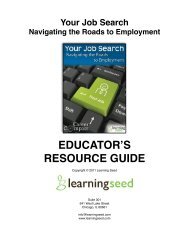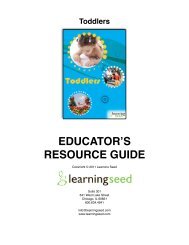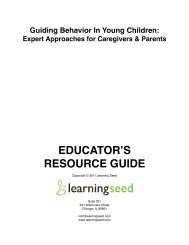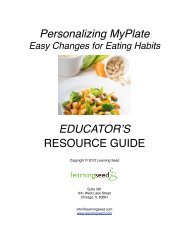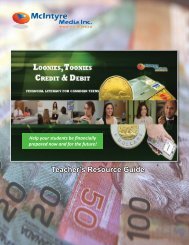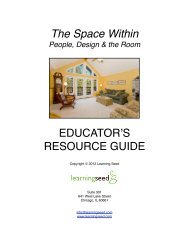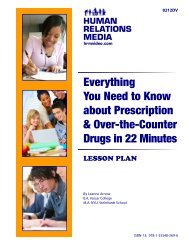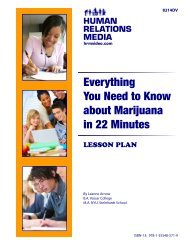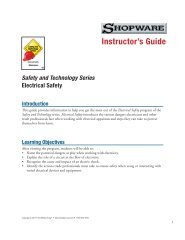EDUCATORʼS RESOURCE GUIDE - Learning Seed
EDUCATORʼS RESOURCE GUIDE - Learning Seed
EDUCATORʼS RESOURCE GUIDE - Learning Seed
Create successful ePaper yourself
Turn your PDF publications into a flip-book with our unique Google optimized e-Paper software.
Worksheet H<br />
Lesson 6a<br />
A Child's Mind: How Kids Learn Right & Wrong! ! ! ! Meet a Theorist Rubric<br />
! ! ! ! ! ! ! ! ! Name _________________________________<br />
CATEGORY 4 3 2 1<br />
Knowledge<br />
Questions & Answers<br />
Interest and Purpose<br />
Preparedness<br />
All students showed<br />
excellent knowledge of<br />
the topic, needing no<br />
prompts and help from<br />
note cards<br />
only 1 or 2 times.<br />
Excellent, in-depth,<br />
on-topic questions<br />
were asked and<br />
excellent answers<br />
supported by facts<br />
were provided.<br />
Interview has a clear<br />
and interesting<br />
purpose.<br />
Students showed<br />
excellent<br />
preparedness having<br />
all of their questions<br />
and responses<br />
prepared and needing<br />
no reminders<br />
about their role.<br />
How to Use this Rubric for Assessment:<br />
All students showed<br />
excellent knowledge of<br />
the topic, but needed<br />
note cards to talk or<br />
answer questions<br />
3 or 4 times.<br />
Good, on-topic<br />
questions requiring<br />
factual answers were<br />
asked and correct,<br />
in-depth answers<br />
were provided.<br />
Interview is interesting<br />
but purpose is<br />
somewhat unclear.<br />
Students showed<br />
excellent<br />
preparedness having<br />
all of their questions<br />
and responses<br />
prepared but needed<br />
1 or 2 reminders<br />
about their role.<br />
Most students showed<br />
moderate knowledge of<br />
the topic, but often<br />
needed note cards to<br />
talk or answer<br />
questions.<br />
Mostly on-topic<br />
questions requiring<br />
factual answers were<br />
asked and correct<br />
answers were provided.<br />
Interview is not very<br />
interesting and purpose<br />
is somewhat unclear.<br />
Most students showed<br />
no knowledge of the<br />
topic, and needed note<br />
cards to talk and to<br />
answer most questions.<br />
Many off-topic<br />
questions were asked<br />
and incorrect answers<br />
were given.<br />
Interview is not<br />
interesting and has no<br />
discernible purpose.<br />
Students showed Students showed<br />
moderate<br />
little<br />
preparedness having preparedness had<br />
1 or 2 of their questions 0 or 1 of their questions<br />
and responses and answers prepared<br />
prepared and needing and relied on<br />
multiple reminders constant reminders<br />
about their role. about their role.<br />
A rubric is a useful tool for ensuring fair and consistent grading methods. Our rubrics score studentʼs work and<br />
performance in a variety of categories. To use our rubric, identify where a studentʼs work falls in each category. Each<br />
level of the category is assigned a number value. Add up the scores that your studentʼs work has earned and divide<br />
by a perfect score of 16 to assign his or her grade. For example: 4 + 3 + 1 + 4 = 12, the grade is 12/16.<br />
Copyright 2011 <strong>Learning</strong> <strong>Seed</strong>




